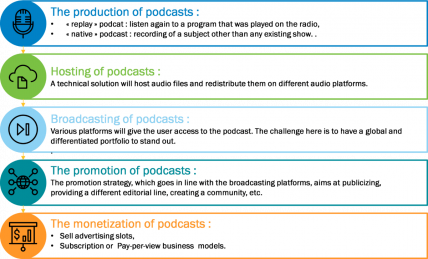While the COVID-19 pandemic is compromising the radio industry, traditionally heavenly consumed in commuting to work, it seems that consumers’ appetite for audio content has increased, especially listening to podcasts. In fact, although it has existed for quite a while, notably for the replay of radio shows, the podcast has gone from a niche market to mainstream use in just a few years. Here is an overview of this dynamic industry, between analysis of the value chain and the players, business models and positioning for the operator.
A classic value chain of the content sector
The podcast value chain is positioned in the same dynamic as that of video content, and revolves around 5 major areas, from production to monetization:

Players increasingly active on the market
In a context where photo and video prevail, voice and audio are gaining ground. Thanks to a less conventional and more private line, the podcast makes it possible to address the audience in a new way, as its format also allows it to satisfy a connected and mobile lifestyle.
On December 20th, 2020, Amazon announced that it is entering the podcast market by acquiring Wondery, a major player in podcast shows in the United States. In parallel, Netflix launched (in beta testing) a 100% audio mode that allows the public to listen to its shows as podcasts. These major movements are symbolic of an increasingly attractive market. However, a number of companies are already established on the market, on all or part of the value chain. Let’s name a few on the French market:
- Producers: Binge, Moustic, Podcut, Majelan (broadcaster as well), …
- Technical host: SoundCloud (broadcaster as well), Triton, PodBean, Art19, …
- Broadcasters (aggregators): Deezer (monetization as well), Spotify (monetization as well), Radioline, …
- Monetization: M6 advertising, Lagardère, Next Média, NRJ, …
A business model between advertising and subscription
Three main axes can be highlighted in terms of monetization of the podcast: a system of free access, financed by advertising (and data), a system of purchase, on demand or by subscription, and finally a system of sponsorship, between a brand and a program.
In the first model, the audio content is available to the user for free. The profitability of the model, and the remuneration of the various players in the value chain is then ensured by advertising at frequent intervals. If this can lead to a degraded user experience, it will satisfy the consumer who does not want to spend more in a highly competitive environment on content (Netflix, Disney +, …). Eventually, and especially for GAFA players, we can even imagine a use or resale of user data in order to offer targeted advertising or produce content closer and closer to expectations.
In the second scheme, the podcast is sold via a subscription or on-demand system (listening or download). The challenge here is to provide an extensive, varied and original podcast catalog in order to stand out from the competition and thus offer a unique and complete user experience.
Finally, the third formula, similar to a print advertorial, allows a brand to finance a podcast in order to increase its visibility, to teach about certain products, to develop its story telling or to restore the relationship of trust with its customers.
The operator plays a role
What role can the operator play in this high-density market? Several avenues for reflection can be imagined.
First of all, the operator has important assets:
- A huge customer base
- A strong presence in homes: boxes, connected objects, speakers, …
- The ability to reach customers easily and directly through SMS campaigns, “try & buy” campaigns on the box, etc,
- An environment and community already in place.
Being aware of its strengths, the operator can then choose to invest more or less intensely in the podcast market:
- As a podcasts aggregator (broadcasting): bring together, in a dedicated area, a set of programs from different producers,
- As a podcasts producer: the operator knows its audience (clients) and can thus be pertinent at this level by producing content that matches the expectations and profiles of users (seniors, family, etc.)
- As a podcasts monetization agent: via an advertising agency for example, by capitalizing on its existing means to sell advertising space on its websites, etc.
Finally, positioning in the podcast segment is also a strategic challenge for the operator. Firstly, from a business point of view, by generating revenue via a podcast offer that could be sold as a “standalone” option or included in its “premium” offers, with the aim of switching customers to more extensive and therefore more expensive offers. Secondly, in terms of image, by reinforcing its image as a trusted and agile partner on the digital market.





